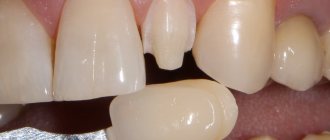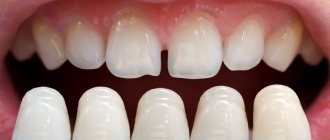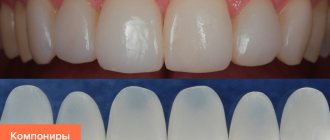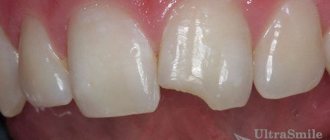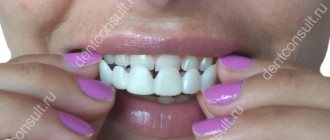Dental veneers are microprostheses that are installed to restore the correct shape of teeth and improve their color. They are recommended when classical methods of whitening and removing defects have not brought positive results. The structures are practically no different from natural teeth. Unlike classic dentures, plates made of composite materials, ceramics and porcelain are strengthened only on the front surface of the teeth. Fixed prosthetics always require turning. Correct defects with veneers without grinding teeth. Is this really possible?
Veneers and teeth grinding are the main problems
With the help of veneers, aesthetic and functional problems are solved. They change the shape of teeth, eliminate unevenness in the enamel, hide yellowness and pigmentation, the presence of old fillings, external defects, and reduce large gaps between teeth. Installing veneers not only restores your smile to its lost beauty, but also rejuvenates your face.
Although the thickness of veneers ranges from 0.2 mm-0.5 mm, they are considered very reliable and have little wear. Thin plates must have a high density of contact with the tooth. This requires preliminary grinding. This procedure often becomes an insurmountable obstacle for patients who are candidates for veneers. How does the preparation process take place and does it really seriously harm the teeth?
Should you be afraid of enamel grinding: what experts say
Professional doctors always warn their patients that before installing veneers, grinding of the enamel is necessary so that the restored teeth look as natural and natural as possible, as well as so that the structures themselves remain firmly and long in the oral cavity.
However, experts emphasize that patients should evaluate in advance all the disadvantages and advantages of the overlays. For example, this disadvantage is covered by a lot of undeniable advantages: the structures protect sensitive enamel from external influences, protect from the development of caries and other dental diseases (naturally, with good oral hygiene), from pathological abrasion and destruction. If the onlays were installed by a professional with experience, then he will prepare the enamel as carefully and safely as possible, and the plates themselves will make your smile perfect for many years to come. In addition, the installation will allow you to comprehensively and quickly solve a number of problems at once: avoid long-term wearing of braces, professional whitening procedures, remineralization and fluoridation.
Is it possible to install veneers without turning?
In most situations, standard porcelain veneers cannot be installed without grinding. However, the use of modern technologies makes it possible to create veneers of smaller thickness, up to a maximum of 1 mm. Strong grinding exposes dentin, as a result of which porcelain adheres much less well. Minimal grinding allows you to preserve healthy enamel, on which veneers adhere much better.
The stitching procedure is not required in the following situations:
- with severe tooth wear;
- obvious unevenness of the cutting edge;
- incorrect position of teeth;
- with an initial lack of volume;
- if installation without stitching looks more aesthetically pleasing;
- crooked teeth.
In such cases, lumineers and ultraneers are recommended, which do not require preliminary tooth preparation. Their installation requires only minimal processing, which is carried out without anesthesia.
Recommendations for selection
A specialist should select the composite material for creating veneers.
But when choosing, he should focus on the following criteria:
- High degree of radiopacity of the composite, which will be used to create veneers on teeth with the greatest load.
- Excellent compatibility with dental tissues, complete sealing of internal teeth.
- Abrasion resistance, maximum tensile and compressive strength.
- Ease of use. The material should easily fill gaps without creating problems during formation.
- Biocompatibility with dental tissues and oral cavity.
- Long service life without deterioration of material properties.
- Maximum matching of color and gloss, transparency of the material.
- Versatility.
- Availability.
Disadvantages of installing plates without turning
Veneers without grinding have a number of disadvantages. These include: increased tooth thickness, which seriously affects aesthetics, the risk of serious problems during wear, and the impossibility of eliminating all defects.
In order for the veneers to adhere better, the surface of the enamel must first be etched with a special acid, as a result of which its appearance will be seriously and irreversibly changed. In the future, plates will definitely have to be installed on such teeth. The small thickness of lumineers cannot completely hide all shape defects.
Preliminary grinding ensures the creation of a smooth and high-quality transition into dental tissue. Installation without grinding provokes the formation of caries, plaque accumulation and gum inflammation.
Stages of installation of overlays
Stage 1: preparation. Professional oral hygiene is carried out, plaque and hard deposits are removed. If necessary, you also need to cure caries and replace old fillings.
Stage 2: enamel preparation. Depending on the type of design chosen, the doctor removes the required layer of hard tissue and levels the surface of the tooth. To determine how thick the tissue needs to be removed, the doctor first makes grooves on them. In the cervical area, the specialist creates a groove-shaped ledge. Also, when installing onlays made of ceramics or zirconium dioxide, it is necessary to treat the side surfaces that cut the edges of the teeth.
Stage 3: etching the enamel with acid. The doctor roughens the enamel so that it can subsequently bond tightly with the artificial material.
Stage 4: if the structures are made using a laboratory method, the doctor will first take impressions and then install plastic “caps” on the prepared units, which will protect sensitive tissues from temperature changes and bacterial attacks. In most cases, you will not need to wear protective covers before having lumineers installed.
Stage 5: trying on the overlays, fixing them first with temporary and then with permanent glue.
How is turning for veneers carried out?
Turning is carried out in several stages:
- using a diamond bur, grooves are created in a transverse direction;
- the tooth surface is polished;
- the middle surfaces directed towards the adjacent teeth are ground down;
- the cutting edge is ground (from 0.5mm to 2mm);
- the palatal surface is worn away.
Finally, final processing is performed, during which sharp corners are rounded and protruding edges are eliminated. For comfortable installation of the plate, the protrusions are removed to the level of the arch, and the entire tooth is ground. This is necessary to ensure that the veneers and teeth are not damaged after installation.
The dental procedure is considered completely painless. The veneer is installed on the tooth without anesthesia or using modern analgesics. The plate is carefully glued to the surface, and the remaining glue is removed. As a result, the appearance of the teeth becomes ideal.
How to avoid complications
The skill of the dentist plays a huge role when installing veneers. If the doctor, through negligence, reaches the dentin, this already threatens poor adhesion (adhesion). And if it touches the pulp, the result can be very sad: acute or chronic pulpitis, secondary caries. Therefore, the dentist must follow certain rules when preparing teeth for veneers:
- Interrupt preparation regularly to check
- Use air-water cooling
- Obey speed limits
- Carry out gum retraction (a thread is inserted under the gingival margin to avoid damage)
The strength of adhesion depends on how the teeth are ground down for veneers, but leaving too thick a layer of enamel is also not good. The pad will protrude and the edge seal will not provide protection against micro-leakage. This will lead to bacterial growth, caries and inflammation.
After the preparation, the dentist makes an impression of the jaws and places temporary veneers
. They are made of acrylic plastic, they are quite fragile, and most importantly, they are not put on each tooth separately, but represent a one-piece structure.
The doctor transfers the impressions to the laboratory, where the technician, using one of 3 available technologies, makes individual onlays. They exactly repeat the anatomy of the tooth, and look like natural enamel.
After fitting, the doctor fixes the pads. To do this, he dries the surfaces, treats them with acid, and etches both the tooth and the veneer. Then the adhesive is applied and the plate is secured to the tooth. It is not painful to insert the plates, the discomfort is only from the position with the mouth open.
Permanent veneers
After this, the patient’s area of responsibility begins. Veneers are strong but thin. Therefore, you need to be careful and avoid traumatic situations:
- do not chew nuts and seeds;
- do not bite the threads;
- Do contact sports while wearing a mouth guard.
Otherwise, caring for veneers is the most common: daily brushing, flossing, regular professional cleaning and preventive examinations every six months.
Types of veneers with minimal grinding of teeth
There are several types of veneers used as long as there is minimal tooth grinding. Composite veneers of high quality and aesthetics are manufactured in production conditions in order to be adapted in the clinic to the needs of a specific patient.
Ceramic plates allow you to get a highly aesthetic and durable result in one visit. Veneers are made in dental laboratories. To do this, an exact impression is first taken and a plaster model is cast, on the basis of which ceramic veneers are made.
How are veneers installed without grinding? First, the patient is asked to take a photograph of the jaw, then a computer simulation of the selected option occurs. After 2-3 weeks, a second appointment is scheduled to try on laboratory samples. The final installation of veneers is carried out after professional teeth cleaning.
Advantages and disadvantages of products
Using veneers without grinding the teeth has many advantages. The designs have the following advantages:
- You don't need to prepare your teeth to get a beautiful smile. This is especially important if the teeth are healthy, but have an irregular shape or dark color.
- The correction is made quickly and painlessly.
- If the patient does not have bad habits and takes proper care of his teeth, then ceramic or zirconium veneers will serve him for 15 years.
- The cost of onlays is much lower than that of ceramic dentures.
Without preparation veneers also have certain disadvantages. Their disadvantages include the following facts:
- A thin veneer does not hide all tooth defects.
- Before installing a microprosthesis, the tooth enamel is etched, so in the future it is impossible to simply remove the veneer and walk without it.
- It is not always possible to make a smooth transition between the product and dental tissues without grinding. If not properly cared for, this can lead to plaque formation in the cervical area.
- Teeth visually become thicker.
Service price
Services for installing veneers with minimal grinding are provided by the best orthopedic dentists in Moscow. The cost of veneers with minimal grinding of teeth directly depends on the level of the clinic, the professionalism of the doctor and the selected material. This also includes the work of dental technicians and medical personnel.
The high cost is justified by the need for careful work to recreate the transparency of the enamel and its microrelief, the complexity of color transfer and restoration of the tooth structure.
Highly artistic veneers, invisible in the oral cavity, which look absolutely natural, cannot cost 30 thousand
rubles.
The price of such products starts from 50-60 thousand rubles. for one unit. Records made from aesthetic materials made in America will cost even more, however, they will last at least 15 years.
Kinds
Ease of manufacture and installation, affordable price – these are the advantages that make composite veneers popular today. Veneers can be made from various composite materials that have a photopolymerization curing mechanism.
This means that in order for the material to become hard and retain its shape, it will be necessary to use special LED lamps that emit blue light. Materials are classified according to the particle size of the filler present in the composition.
Plates with huge composite particles
Such plates include a composite whose molecules have a size of 8-12 microns, and in some versions even larger. Such materials are highly durable, but are difficult to polish, and all due to the fact that the composite particles are large. This is a significant disadvantage of this type - an unattractive appearance after restoration.
Veneers with small particles of composite
The size of this type of composite is no more than 3 microns. This type has satisfactory aesthetic characteristics, while this does not affect the strength in any way.
Plates with hybrid composites
This group of plates is popular among dentists. Such veneers have maximum strength and excellent aesthetic properties. Molecules of different sizes are introduced into the composite of such veneers. There are several types of similar products, all of them are described in the table below.
| Name | Description |
| Macrohybrid | Particle sizes can be from 0.04 to 12 microns. |
| Microhybrid | Molecular sizes range from 0.04 to 5 microns. |
| Nanohybrid | Particles with a diameter of no more than 2 microns. |
Plates with microparticles
This composite has high indicators of aesthetics and polishability, but due to the presence of molecules of only small size - no more than 0.4 microns, therefore the strength indicators are low. These types of veneers are not recommended for use when creating large structures and on teeth that are subject to high chewing load.
How long will the results last?
Composite materials without turning can last from 3 to 8 years. Their rapid destruction can occur due to injury, contact with hard objects on the teeth during a meal, and other types of mechanical impact.
If the recommendations are not followed, after a short period of time the material fixing the prosthesis may lose its strength and the plate will come off. In this case, you can simply contact a specialist, he will return everything to its place and securely fix the plate again.
Who are veneers indicated for?
Some aesthetic problems with teeth can be easily corrected with the help of onlays. These problems include:
- Unattractive shape of teeth
- Enamel defects (cracks, pronounced scratches, chips)
- Slight curvature of the dentition (for many, the front teeth are not located on the same line, but have different angles of inclination)
- Change in tooth enamel color (darkening, yellowing)
- Need to hide a large filling on the anterior unit
Life time
Magicneers veneers have an unlimited useful life, which means that ceramic veneers can last a lifetime without needing to be replaced. With a minimum thickness (only 0.2-0.3 mm!) they have solid strength and are able to withstand mechanical loads.
For the long service of Magicneers veneers, it is important to follow all the doctor’s recommendations, do not chew seeds, hard crusts of bread, do not try to crack nuts with your teeth and open bottles, and also ensure high-quality oral hygiene, in which it is important to use not only a brush and paste, but also an irrigator, helping to remove plaque and food debris from the most inaccessible places.
Disadvantages of veneering without turning
If you install veneers without grinding, they will not adhere well to the enamel, will not withstand the chewing load and may break off. On large and long teeth, the plates will look unaesthetic, resembling “horse teeth”. Also, thick veneers can put pressure on the mucous membrane of the lips, make it difficult to chew food, and can even change the bite.
If there are small depressions and bumps on thick enamel, microscopic gaps remain between them and the veneer. Bacteria begin to multiply in them, since the antimicrobial factors of saliva do not act on them under veneers. As a result, bacteria easily dissolve the mineral substances of the tooth and quickly destroy it.
If the dentist does not treat the cervical area under the gum, the transition from the plate to the gum will be noticeable. Food will accumulate between the gum and the structure, injuring the soft tissue.
If the enamel darkens, the dentist cannot place thin veneers without grinding, since the shade will show through the transparent ceramic. Also, ultra-thin laminates will not be able to hide significant defects.
Although laminates are considered a reversible fixed prosthesis, they are secured with phosphoric acid gel, which significantly destroys the enamel. If the patient wants to remove ultraneers or lumineers, the damaged layer will have to be ground down; in some cases, the teeth may change color.
Lumineers without grinding last a little less than thick ceramic ones. Thin ultraneers can only be placed on the upper incisors, and they must be changed every 5 years.
Adhesive bridges (AMP)
As the name suggests, this is just a modification of the classic “bridges,” which consist of abutment crowns cemented onto the ground adjacent teeth and a pontic that fills in the missing tooth(s).
With an adhesive bridge, virtually everything is the same. Only it is not supported by crowns, but by filling material. The most common option for making such a prosthesis looks like this:
- missing lower incisor
- creating small cuts on adjacent teeth
— fixation of the fiberglass base of the artificial tooth in these cuts
- finished work
There are different variations of this technique, incl. and making the denture in a dental laboratory rather than in the mouth, which is preferable. But be that as it may... the essence remains the same. What are the advantages here?
- less aggressive preparation (compared to making crowns) ... but still, as can be seen from the example, “without turning” does not work;
— speed of production (in one visit you get the finished result)
That's all the pros... What about the cons? In short:
- one way or another, the teeth adjacent to the defect need preparation. Those. In this regard, this technique is already inferior to implantation, when neighboring teeth do not suffer at all due to missing ones.
— very weak mechanical strength of such structures. The support area is too small to support significant loads, so AMPs are manufactured only for a short time (for example, while awaiting implantation) and only for aesthetic purposes; they cannot provide a full function for a long time. In addition, it is reasonable to restore only some teeth in this way (upper/lower 5s, lower incisors, upper 2s), because these teeth do not bear a serious chewing load.
adhesive bridges are most often made . Over time, any composite material loses its original shine and accumulates soft plaque more easily than other materials, leading to the development of secondary caries on the supporting teeth.
- questionable aesthetics
Using the example of this zirconia-based on an implant, you can notice a significant difference in aesthetics between this method of prosthetics and AMP
- additional load on neighboring teeth, as in the case of a conventional bridge. Teeth are not horses, and they don’t like being tied together in one harness. Plus, it always makes hygiene difficult.
- loss of bone tissue in the area of the extracted tooth due to atrophy. Without load, the bone in the area of the extracted tooth gradually atrophies, worsening the conditions for possible implantation. “Settling” of the bone along with the gum gradually worsens the aesthetics of the bridge itself (this is especially important in the anterior section), because It becomes noticeable that the artificial tooth is “hanging in the air.”
Here is such a considerable list... Ultimately, the service life of AMPs under ideal conditions is usually about 5 years in the best case. In practice, problems most often begin much earlier. Therefore, such designs are of little use for permanent prosthetics.
